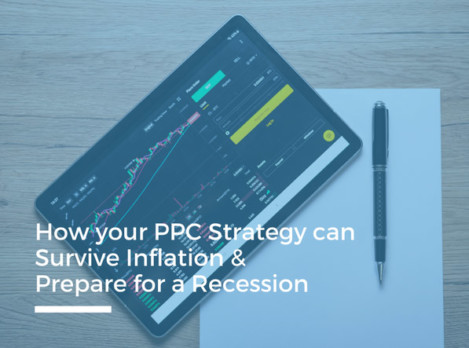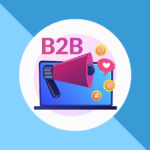Economic Cycles and your PPC Advertising
As we’ve all faced a rise in pricing in our supermarkets and restaurants, we have also noticed an increase in pricing in the world of digital advertising. Fortunately, there are some solutions that can help reduce the impact of our current state of inflation and the looming recession.
Every economic state is cyclical; we can try to soften the blows of the downward cycles and put a ceiling on the upward cycles, but there is only so much that can be controlled. In every economic cycle there are 4 stages: expansion, peak, contraction, and trough. Those terms are fairly self-explanatory, so I’ll spare you the Econ 101 lesson. What’s important for our purposes is that inflation is a phenomenon that arises once an economy has reached its natural peak and is typically the first symptom of an overextended economy correcting itself… and it has an effect on everything, even PPC.
What Inflation Looks Like from a PPC Perspective
In PPC we see inflation in the form of a noticeable increase in cost-per-click; for example, one of our more local clients is currently experiencing a year-over-year average cost-per-click increase of about 19.5%. Granted, this is one of our more extreme examples, it is a good indication of the impact global inflation has on paid search advertising. At some point, that price could increase to a value where the cost of a single click may not be worth the traffic that click brings to a client’s web page. Under the right circumstances, that kind of inflation could price some companies right out of the paid search marketplace. One thing we are also seeing on occasion is a decline in impressions while clicks remain constant. So far, the cases in our client list have been minor, but it is a trend worth noting.
What a Recession Looks Like from a PPC Perspective
When it comes to a recession, the signs present themselves as tumbleweeds. In otherwise traffic-rich areas, the movement seems to stop. When this happens, every dollar becomes more crucial to the consumer, leading to a decline in search volume for luxury items like vacations, new cars, home renos, etc. While costs may or may not increase, the search volume is just not there to drive traffic or conversions. This ends up leading many to cut their PPC budgets, and an estimated 50% of advertisers will bow out of the marketplace all together. But it doesn’t have to be that way.
Okay, So What Can Be Done to Fight Inflation in Advertising Costs?
As my dad often says, “there’s always something that can be done”; as usual, that rings true here.
There are different approaches to manage rising ad costs. This is what we recommend for most advertisers:
How to Reduce Costs for Brand Keywords:
A common migration of bid strategy is more than likely to do the trick here. Go back to basics and start with a manual CPC bid strategy with ‘first page bids’. If you’re not already using a manual strategy, you’ll want to sit there for a couple of weeks to gather some solid data. From there you want to move to maximum clicks with an uncapped CPC for at least three weeks before capping your CPC (optional).
Max clicks are designed to stretch your dollar by finding the cheapest possible clicks. In times of rising costs, this can be a highly effective way of keeping costs low. This will work best for branded terms because the intent of the search query is to find your brand, so even the cheapest clicks will come with a certain degree of confidence. Make sure your quality scores are high and you are likely to achieve a very affordable CPC.
How to Reduce Costs for Mid-Funnel Keywords
The success of a max clicks bid strategy is less certain when it comes to mid-funnel terms, because the search intent of any give query can vary. It can work, but unless your keywords are longtail keywords, the quality of those cheap clicks is far from guaranteed.
To reduce your ad costs for mid-funnel keywords, we recommend doing a campaign “reset”. If you are using a maximize conversions strategy with a target CPA, go back to a manual bid strategy to reset the algorithm. After a few weeks, assuming your CPCs have dropped, you can switch to maximize conversions. If the campaign is low volume, you may want to spend a bit of time at max clicks to build more data. Once you are comfortable with your results, add a target CPA if you prefer.
This approach works because CPCs rise if competition rises or if volume decreases. A target CPA can stifle volume, which leads to increased cost. Now, this method is not for the faint of heart, as you may see a short-term loss of efficiency. But if ad spend is a significant issue for your campaign, this is one approach that may reduce your overall costs.
How to Reduce Costs for Top-of-Funnel Keywords
For top-of-funnel terms, you want to follow the same model as with branded terms, with one key caveat, the CPC cap is not optional. This will allow for the greatest volume of cheap clicks.
How Should My PPC Strategy Change During a Recession?
This becomes a much more difficult business conversation. Often advertisers pull out of the PPC market during a downturn but maintaining your advertising campaigns during a recession can be highly beneficial if you can afford it, especially if competition is low. Essentially, there are two things that can be done here, and the decision comes down to more of a business strategy than a PPC strategy.
The first approach is to shift the traditional view of how a business generates profits and recognize that sometimes reducing costs can be as valuable as driving revenue, if you maintain a strong ROI.
In this model, you scale back on everything that’s not considered bottom-of-the-funnel or branded keywords. As costs rise, you decide to remove yourself from the competitive auctions, and just wait out the madness. You’ll notice a lot less traffic to your website, but the traffic that does come your way will be highly qualified traffic specifically seeking out what it is you provide. After two quarters you should have generated a high enough ROI to comfortably return to your normal PPC practices and refocus on maximizing revenue.
It’s important to note that this only works if you have enough financial runway or returning business to allow for a slow period in new leads.
The second method is a more aggressive approach. Essentially, you ignore the decline in demand and march on, or even redirect funding from somewhere else towards PPC.
The idea here is to position yourself in front of as many relevant search queries as possible, to combat a decrease in total search queries. You may want to avoid looking at your ROI for a while, as it will plummet, but hey, the lights are still on!
Again, you should plan to let this go on for two, maybe three, quarters before taking the foot off the gas. At which point you will return your focus towards ROI by spending less.
What Is Best for Me?
Of course, it would be great if we never had to deal with economic downswings, but they happen. Each situation is unique; how you plan to fight off a downward shift in the economic landscape is dependent on several factors specific to your business. The key is to be prepared and have a support system in place. At Ontario SEO we pride ourselves on being part of that support system for each one of our clients and using our skills and expertise to do what we can to help them through times of uncertainty.








